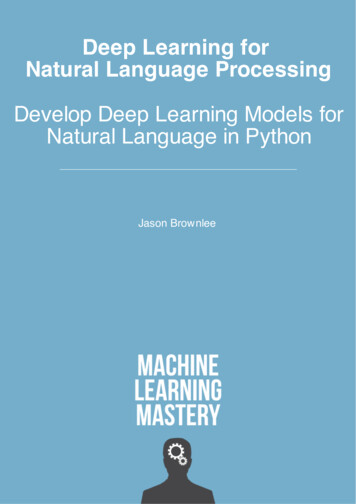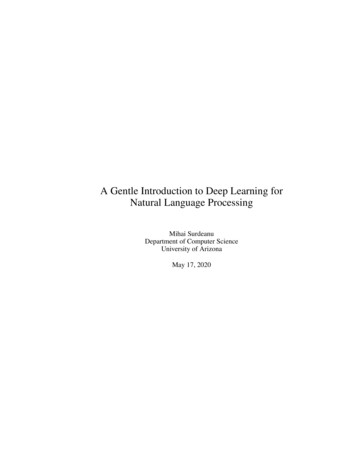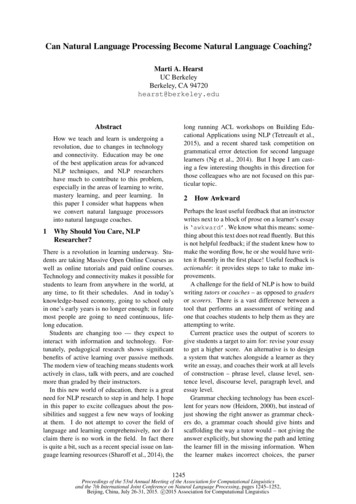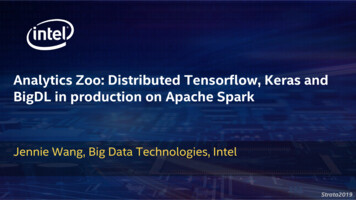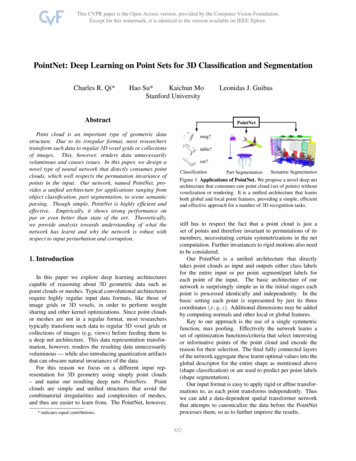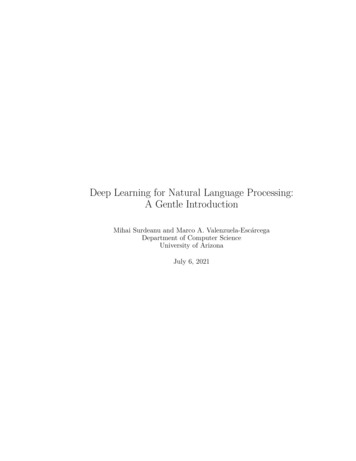
Transcription
Deep Learning for Natural Language Processing:A Gentle IntroductionMihai Surdeanu and Marco A. Valenzuela-EscárcegaDepartment of Computer ScienceUniversity of ArizonaJuly 6, 2021
ContentsPreface . . . . . . . . . . . . . . . . . . . . . . . . . . . . . . . . . . . . . .1 Introduction1.1 What this Book Covers . . . . .1.2 What this Book Does Not Cover1.3 Deep Learning Is Not Perfect . .1.4 Mathematical Notations . . . . .2 The2.12.22.32.42.52.62.72.82.9.PerceptronMachine Learning Is Easy . . . . . . . . . .Use Case: Text Classification . . . . . . . .Evaluation Measures for Text ClassificationThe Perceptron . . . . . . . . . . . . . . . .Voting Perceptron . . . . . . . . . . . . . .Average Perceptron . . . . . . . . . . . . . .Drawbacks of the Perceptron . . . . . . . .Historical Background . . . . . . . . . . . .References and Further Readings . . . . . .3 Logistic Regression3.1 The Logistic Regression Decision Function and Learning3.2 The Logistic Regression Cost Function . . . . . . . . . .3.3 Gradient Descent . . . . . . . . . . . . . . . . . . . . . .3.4 Deriving the Logistic Regression Update Rule . . . . . .3.5 From Binary to Multiclass Classification . . . . . . . . .3.6 Evaluation Measures for Multiclass Text Classification .3.7 Drawbacks of Logistic Regression . . . . . . . . . . . . .3.8 Historical Background . . . . . . . . . . . . . . . . . . .3.9 References and Further Readings . . . . . . . . . . . . .Algorithm. . . . . . . . . . . . . . . . . . . . . . . . . . . . . . . . . . . . . . . . 4 Implementing a Review Classifier Using Logistic Regression515 Feed Forward Neural Networks5.1 Architecture of Feed Forward Neural Networks . . . . . . . . . . . . .5353iii
ivCONTENTS5.25.35.45.55.6Learning Algorithm for Neural NetworksThe Equations of Back-propagation . . .Drawbacks of Neural Networks (So Far)Historical Background . . . . . . . . . .References and Further Readings . . . .57586465656 Best Practices in Deep Learning6.1 Mini-batching . . . . . . . . . . . . . . . . .6.2 Other Optimization Algorithms . . . . . . .6.3 Other Activation Functions . . . . . . . . .6.4 Cost Functions . . . . . . . . . . . . . . . .6.5 Regularization . . . . . . . . . . . . . . . .6.6 Dropout . . . . . . . . . . . . . . . . . . . .6.7 Temporal Averaging . . . . . . . . . . . . .6.8 Parameter Initialization and Normalization.6767717477798183837 Implementing the Review Classifier with Feed Forward Networks8 Distributional Hypothesis and Representation Learning8.1 Traditional Distributional Representations . . . . . . . . . . . . . . . .8.2 Matrix Decompositions and Low-rank Approximations . . . . . . . . .8.3 Drawbacks of Representation Learning Using Low-Rank Approximation8.4 The Word2vec Algorithm . . . . . . . . . . . . . . . . . . . . . . . . .8.5 Drawbacks of the Word2vec Algorithm . . . . . . . . . . . . . . . . . .8.6 Historical Background . . . . . . . . . . . . . . . . . . . . . . . . . . .8.7 References and Further Readings . . . . . . . . . . . . . . . . . . . . .8789899295951011021029 Implementing the Neural Review Classifier Using Word Embeddings10310 Contextualized Embeddings and Transformer Networks10511 Using Transformers with the Hugging Face Library10712 Sequence Models10913 Implementing Sequence Models11114 Sequence-to-sequence Methods11315 Domain Transfer11516 Semi-supervised Learning and Other Advanced Topics117
CONTENTS vA Overview of the Python Programming LanguageB Character Encodings: ASCII and UnicodeB.1 How Do Computers Represent Text? . . . .B.2 Text Normalization . . . . . . . . . . . . . .B.2.1 Unicode Normalization Forms . . . .B.2.2 Case-folding . . . . . . . . . . . . . .119.121121125126127
PrefaceAn obvious question that may pop up when seeing this material is: ”Why anotherdeep learning and natural language processing book?” Several excellent ones havebeen published, covering both theoretical and practical aspects of deep learning andits application to language processing. However, from my experience teaching courseson natural language processing, I argue that, despite their excellent quality, mostof these books do not target their most likely readers. The intended reader of thisbook is one who is skilled in a domain other than machine learning and naturallanguage processing and whose work relies, at least partially, on the automated analysisof large amounts of data, especially textual data. Such experts may include socialscientists, political scientists, biomedical scientists, and even computer scientists andcomputational linguists with limited exposure to machine learning.Existing deep learning and natural language processing books generally fall intotwo camps. The first camp focuses on the theoretical foundations of deep learning.This is certainly useful to the aforementioned readers, as one should understand thetheoretical aspects of a tool before using it. However, these books tend to assume thetypical background of a machine learning researcher and, as a consequence, I have oftenseen students who do not have this background rapidly get lost in such material. Tomitigate this issue, the second type of book that exists today focuses on the machinelearning practitioner; that is, on how to use deep learning software, with minimalattention paid to the theoretical aspects. I argue that focusing on practical aspects issimilarly necessary but not sufficient. Considering that deep learning frameworks andlibraries have gotten fairly complex, the chance of misusing them due to theoreticalmisunderstandings is high. I have commonly seen this problem in my courses, too.This book, therefor, aims to bridge the theoretical and practical aspects of deeplearning for natural language processing. I cover the necessary theoretical backgroundand assume minimal machine learning background from the reader. My aim is thatanyone who took linear algebra and calculus courses will be able to follow thetheoretical material. To address practical aspects, this book includes pseudo codefor the simpler algorithms discussed and actual Python code for the more complicatedarchitectures. The code should be understandable by anyone who has taken a Pythonprogramming course. After reading this book, I expect that the reader will havethe necessary foundation to immediately begin building real-world, practical naturalvii
viiiCONTENTSlanguage processing systems, and to expand their knowledge by reading researchpublications on these topics.AcknowledgmentsYour acknowledgments: TODO: Thank you to all the people who helped!Mihai and Marco
1IntroductionMachine learning (ML) has become a pervasive part of our lives. For example, PedroDomingos, a machine learning faculty member at University of Washington, discussesa typical day in the life of a 21st century person, showing how she is accompaniedby machine learning applications throughout the day from early in the morning (e.g.,waking up to music that the machine matched to her preferences) to late at night(e.g., taking a drug designed by a biomedical researcher with the help of a robotscientist) [Domingos 2015].Natural language processing (NLP) is an important subfield of ML. As an exampleof its usefulness, consider that PubMed, a repository of biomedical publications builtby the National Institutes of Health,1 has indexed more than one million researchpublications per year since 2010 [Vardakas et al. 2015]. Clearly, no human reader (orteam of readers) can process so much material. We need machines to help us managethis vast amount of knowledge. As one example out of many, an inter-disciplinarycollaboration that included our research team showed that machine reading discoversan order of magnitude more protein signaling pathways2 in biomedical literature thanexist today in humanly-curated knowledge bases [Valenzuela-Escárcega et al. 2018].Only 60 to 80% of these automatically-discovered biomedical interactions are correct(a good motivation for not letting the machines work alone!). But, without NLP, allof these would remain “undiscovered public knowledge” [Swanson 1986], limiting ourability to understand important diseases such as cancer. Other important and morecommon applications of NLP include web search, machine translation, and speechrecognition, all of which have had a major impact in almost everyone’s life.Since approximately 2014, the “deep learning tsunami” has hit the field ofNLP [Manning 2015] to the point that, today, a majority of NLP publications usedeep learning. For example, the percentage of deep learning publications at four topNLP conferences has increased from under 40% in 2012 to 70% in 2017 [Young et al.2018]. There is good reason for this domination: deep learning systems are relativelyeasy to build (due to their modularity), and they perform better than many other ML1 https://www.ncbi.nlm.nih.gov/pubmed/2 Proteinsignaling pathways “govern basic activities of cells and coordinate multiple-cell actions”.Errors in these pathways “may cause diseases such as cancer”. See: https://en.wikipedia.org/wiki/Cell signaling1
2Chapter 1Introductionmethods.3 For example, the site nlpprogress.com, which keeps track of state-of-the-artresults in many NLP tasks, is dominated by results of deep learning approaches.This book explains deep learning methods for NLP, aiming to cover both theoreticalaspects (e.g., how do neural networks learn?) and practical ones (e.g., how do I buildone for language applications?).The goal of the book is to do this while assuming minimal technical backgroundfrom the reader. The theoretical material in the book should be completely accessibleto the reader who took linear algebra, calculus, and introduction to probabilitytheory courses, or who is willing to do some independent work to catch up. Fromlinear algebra, the most complicated notion used is matrix multiplication. Fromcalculus, we use differentiation and partial differentiation. From probability theory,we use conditional probabilities and independent events. The code examples shouldbe understandable to the reader who took a Python programming course.Starting nearly from scratch aims to address the background of what we thinkwill be the typical reader of this book: an expert in a discipline other than ML andNLP, but who needs ML and NLP for her job. There are many examples of suchdisciplines: the social scientist who needs to mine social media data, the politicalscientist who needs to process transcripts of political discourse, the business analystwho has to parse company financial reports at scale, the biomedical researcher whoneeds to extract cell signaling mechanisms from publications, etc. Further, we hopethis book will also be useful to computer scientists and computational linguists whoneed to catch up with the deep learning wave. In general, this book aims to mitigatethe impostor syndrome [Dickerson 2019] that affects many of us in this era of rapidchange in the field of machine learning and artificial intelligence (this author certainlyhas suffered and still suffers from it!4 ).1.1What this Book CoversThis book interleaves chapters that discuss the theoretical aspects of deep learning forNLP with chapters that focus on implementing the previously discussed theory. Forthe implementation chapters we will use PyTorch, a deep learning library that is wellsuited for NLP applications.5Chapter 2 begins the theory thread of the book by attempting to convince thereader that machine learning is easy. We will use a children’s book to introduce keyML concepts, including our first learning algorithm. From this example, we will startbuilding several basic neural networks. In the same chapter, we will formalize the3 However,they are not perfect. See Section 1.3 for a discussion.the best of us suffer from it. Please see Kevin Knight’s description of his personal experienceinvolving tears (not of joy) in the introduction of this tutorial [Knight 2009].5 https://pytorch.org4 Even
1.1 What this Book Covers 3perceptron algorithm, the simplest neural network. In Chapter 3, we will transformthe perceptron into a logistic regression network, another simple neural network that issurprisingly effective for NLP. In Chapters 5 and 6 we will generalize these algorithmsinto feed forward neural networks, which operate over arbitrary combinations ofartificial neurons.The astute historian of deep learning will have observed that deep learning had animpact earlier on image processing than on NLP. For example, in 2012, researchers atUniversity of Toronto reported a massive improvement in image classification whenusing deep learning [Krizhevsky et al. 2012]. However, it took more than two years toobserve similar performance improvements in NLP. One explanation for this delay isthat image processing starts from very low-level units of information (i.e., the pixelsin the image), which are then hierarchically assembled into blocks that are more andmore semantically meaningful (e.g., lines and circles, then eyes and ears, in the caseof facial recognition). In contrast, NLP starts from words, which are packed with alot more semantic information than pixels and, because of that, are harder to learnfrom. For example, the word house packs a lot of common-sense knowledge (e.g.,houses generally have windows and doors and they provide shelter). Although thisinformation is shared with other words (e.g., building), a learning algorithm that hasseen house in its training data will not know how to handle the word building in a newtext to which it is exposed after training.Chapter 8 addresses this limitation. In it, we discuss word2vec, a method thattransforms words into a numerical representation that captures (some) semanticknowledge. This technique is based on an observation that “you shall know a wordby the company it keeps” [Firth 1957]; that is, it learns from the context in whichwords appear in large collections of texts. Under this representation, similar wordssuch as house and building will have similar representations, which will improve thelearning capability of our neural networks. An important limitation of word2vec is thatit conflates all senses of a given word into a single numerical representation. That is,the word bank gets a single numerical representation regardless of whether its currentcontext indicates a financial sense, e.g., Bank of America, or a geological one, e.g.,bank of the river. In Chapter 10 we will introduce contextualized embeddings, i.e.,numerical representations that are sensitive of the current context in which a wordappears, which address this limitation. These contextualized embeddings are builtusing transformer networks, which rely on “attention,” a is a mechanism that computesthe representation of a word using a weighted average of the representations of thewords in its context. These weights are learned and indicate how much ”attention”each word should put on each of its neighbors (hence the name).Chapter 12 introduces sequence models for processing text. For example, while theword book is syntactically ambiguous (i.e., it can be either a noun or a verb), knowing
4Chapter 1Introductionthat it is preceded by the determiner the in a text gives strong hints that this instanceof it is a noun. In this chapter, we will cover neural network architectures designedto model such sequences, including recurrent neural networks, convolutional neuralnetworks, long short-term memory networks, and long short-term memory networkscombined with conditional random fields.Chapter 14 discusses sequence-to-sequence methods (i.e., methods tailored for NLPtasks where the input is a sequence and the output is another sequence). The mostcommon example of such a task is machine translation; where the input is a sequenceof words in one language, and the output is a sequence that captures the translationof the original text in a new language.Chapter 15 discusses methods that begin to address the “brittleness” of deeplearning when transferring a model from one domain to another. For example, theperformance of a part-of-speech tagging system (i.e., identifying which words arenouns, verbs, etc.) that is trained on well-formed texts, such as newspaper articles,drops precipitously when used on social media texts (see Section 1.3 for a longerdiscussion).Lastly, Chapter 16 discusses approaches for training neural networks with minimalsupervision. For example, training a neural network to detect spam emails normallyrequires many examples of emails that are/are not spam. In this chapter, we introducea few recent directions in deep learning that allow the training of a network from afew examples that are annotated with the desired outcome (e.g., spam or not spam)and with many others that are not.As previously mentioned, the theoretical discussion in these chapters is interleavedwith chapters that discuss how to implement these notions in PyTorch. Chapter 4shows an implementation of the logistic regression algorithm introduced in Chapter 3.Chapter 7 introduces an implementation of the feed forward neural network introducedin Chapters 5 and 6. Chapter 9 enhances the previous implementation of a neuralnetwork with the continuous word representations introduced in Chapter 8. Chapter 11changes the previous implementation of feed forward neural networks to use thecontextualized embeddings generated by a transformer network. Lastly, Chapter 13implements the sequence models introduced in Chapter 12.1.2What this Book Does Not CoverIt is important to note that deep learning is only one of the many subfields of machinelearning. In his book, Domingos provides an intuitive organization of these subfieldsinto five “tribes” [Domingos 2015]:
1.3 Deep Learning Is Not Perfect5Connectionists This tribe focuses on machine learning methods that (shallowly)mimic the structure of the brain. The methods described in this book fall intothis tribe.Evolutionaries The learning algorithms adopted by this group of approaches, alsoknown as genetic algorithms, focus on the “survival of the fittest”. That is, thesealgorithms “mutate” the “DNA“ (or parameters) of the models to be learned, andpreserve the generations that perform the best.Symbolists The symbolists rely on inducing logic rules that explain the data in thetask at hand. For example, a part-of-speech tagging system in this camp maylearn a rule such as if previous word is the, then the part of the speech of thenext word is noun.Bayesians The Bayesians use probabilistic models such as Bayesian networks. Allthese methods are driven by Bayes’ rule, which describes the probability of anevent.Analogizers The analogizers’ methods are motivated by the observation that “youare what you resemble”. For example, a new email is classified as spam becauseit uses content similar to other emails previously classified as such.It is beyond the goal of this book to explain these other tribes in detail. Even from theconnectionist tribe, we will focus mainly on methods that are relevant for languageprocessing.6 For a more general description of machine learning, the interested readershould look to other sources such as Domingos’ book, or Hal Daumé III’s excellentCourse in Machine Learning.71.3Deep Learning Is Not PerfectWhile deep learning has pushed the performance of many machine learning applications beyond what we thought possible just ten years ago, it is certainly not perfect.Gary Marcus and Ernest Davis provide a thoughtful criticism of deep learning in theirbook, Rebooting AI [Marcus and Davis 2019]. Their key arguments are:Deep learning is opaque While deep learning methods often learn well, it is unclearwhat is learned, i.e., what the connections between the network neurons encode.This is dangerous, as biases and bugs may exist in the models learned, and theymay be discovered only too late, when these systems are deployed in importantreal-world applications such as diagnosing medical patients, or self-driving cars.6 Mostof methods discussed in this book are certainly useful and commonly used outside of NLP aswell.7 http://ciml.info
6Chapter 1IntroductionDeep learning is brittle It has been repeatedly shown both in the machine learningliterature and in actual applications that deep learning systems (and for thatmatter most other machine learning approaches) have difficulty adapting to newscenarios they have not seen during training. For example, self-driving cars thatwere trained in regular traffic on US highways or large streets do not know howto react to unexpected scenarios such as a firetruck stopped on a highway.8Deep learning has no common sense An illustrative example for this limitationis that object recognition classifiers based on deep learning tend to confuse objectswhen they are rotated in three-dimensional space, e.g., an overturned bus inthe snow is confused with a snow plow. This happens because deep learningsystems lack the common-sense knowledge that some object features are inherentproperties of the category itself regardless of the object position, e.g., a schoolbus in the US usually has a yellow roof, while some features are just contingentassociations, e.g., snow tends to be present around snow plows. (Most) humansnaturally use common sense, which means that we do generalize better to novelinstances, especially when they are outliers.All the issues raised by Marcus and Davis are unsolved today. However, we will discusssome directions that begin to address them in this book. For example, in Chapter 14we will discuss algorithms that (shallowly) learn common-sense knowledge from largecollections of texts. In Chapter 15 we will introduce strategies to mitigate the pain intransferring deep learning models from one domain to another.1.4Mathematical NotationsWhile we try to rely on plain language as much as possible in this book, mathematicalformalisms cannot (and should not) be avoided. Where mathematical notations arenecessary, we rely on the following conventions: We use lower case characters such as x to represent scalar values, which willgenerally have integer or real values. We use bold lower case characters such as x to represent arrays (or vectors) ofscalar values, and xi to indicate the scalar element at position i in this vector.Unless specified otherwise, we consider all vectors to be column vectors duringoperations such as multiplication, even though we show them in text as horizontal.We use [x; y] to indicate vector concatenation. For example, if x (1, 2) andy (3, 4), then [x; y] (1, 2, 3, 4).8 crash-details/
1.4 Mathematical Notations7 We use bold upper case characters such as X to indicate matrices of scalar values.Similarly, xi j points to the scalar element in the matrix at row i and column j. xiindicates the vector corresponding to the entire row i in matrix X. We collectively refer to matrices of arbitrary dimensions as tensors. By andlarge, in this book tensors will have dimension 1 (i.e., vectors) or 2 (matrices).Occasionally, we will run into tensors with 3 dimensions.
2The PerceptronThis chapter covers the perceptron, the simplest neural network architecture. In general, neural networks are machine learning architectures loosely inspired by the structure of biological brains. The perceptron is the simplest example of such architectures:it contains a single artificial neuron.The perceptron will form the building block for the more complicated architecturesdiscussed later in the book. However, rather than starting directly with the discussionof this algorithm, we will start with something simpler: a children’s book and somefundamental observations about machine learning. From these, we will formalize ourfirst machine learning algorithm, the perceptron. In the following chapters, we willimprove upon the perceptron with logistic regression (Chapter 3), and deeper feedforward neural networks (Chapter 5).2.1Machine Learning Is EasyMachine learning is easy. To convince you of this, let us read a children’s story [Donaldson and Scheffler 2008]. The story starts with a little monkey that lost her mom inthe jungle (Figure 2.1). Luckily, the butterfly offers to help, and collects some information about the mother from the little monkey (Figure 2.2). As a result, the butterflyleads the monkey to an elephant. The monkey explains that her mom is neither graynor big, and does not have a trunk. Instead, her mom has a “tail that coils aroundtrees”. Their journey through the jungle continues until, after many mistakes (e.g.,snake, spider), the pair end up eventually finding the monkey’s mom, and the familyis happily reunited.In addition to the exciting story that kept at least a toddler and this parent gluedto its pages, this book introduces several fundamental observations about (machine)learning.First, objects are described by their properties, also known in machine learningterminology as features. For example, we know that several features apply to themonkey mom: isBig, hasTail, hasColor, numberOfLimbs, etc. These features havevalues, which may be Boolean (true or false), a discrete value from a fixed set, or anumber. For example, the values for the above features are: false, true, brown (outof multiple possible colors), and 4. As we will see soon, it is preferable to convert thesevalues into numbers because most of the machine learning can be reduced to numericoperations such as additions and multiplications. For this reason, Boolean features are9
10Figure 2.1Chapter 2The PerceptronAn exciting children’s book that introduces the fundamentals of machine learning:Where’s My Mom, by Julia Donaldson and Axel Scheffler [Donaldson and Scheffler2008].converted to 0 for false, and 1 for true. Features that take discrete values are convertedto Boolean features by enumerating over the possible values in the set. For example,the color feature is converted into a set of Boolean features such as hasColorBrownwith the value true (or 1), hasColorRed with the value false (or 0), etc.Second, objects are assigned a discrete label, which the learning algorithm orclassifier (the butterfly has this role in our story) will learn how to assign to newobjects. For example, in our story we have two labels: isMyMom and isNotMyMom.When there are two labels to be assigned such as in our story, we call the problemat hand a binary classification problem. When there are more than two labels, theproblem becomes a classification task. Sometimes, the labels are continuous numericvalues, in which case the problem at hand is called a regression task. An example ofsuch a regression problem would be learning to forecast the price of a house on thereal estate market from its properties, e.g., number of bedrooms, and year it was built.However, in NLP most tasks are classification problems (we will see some simple onesin this chapter, and more complex ones starting with Chapter 12).
2.1 Machine Learning Is Easy11Little monkey: “I’ve lost my mom!”“Hush, little monkey, don’t you cry. I’ll help you find her,” said butterfly.“Let’s have a think, How big is she?”“She’s big!” said the monkey. “Bigger than me.””Bigger than you? Then I’ve seen your mom. Come, little monkey, come,come, come.”“No, no, no! That’s an elephant.”Figure 2.2The butterfly tries to help the little monkey find her mom, but fails initially [Donaldsonand Scheffler 2008]. TODO: check fair use!Table 2.1An example of a possible feature matrix X (left table) and a label vector y (righttable) for three animals in our story: elephant, snake, and To formalize what we know so far, we can organize the examples the classifier hasseen (also called a training dataset) into a matrix of features X and a vector of labelsy. Each example seen by the classifier takes a row in X, with each of the featuresoccupying a different column. Each yi is the label of the corresponding example xi .Table 2.1 shows an example of a possible matrix X and label vector y for three animalsin our story.The third observation is that a good learning algorithm aggregates its decisions overmultiple examples with different features. In our story the butterfly learns that somefeatures are positively associated with the mom (i.e., she is likely to have them), whilesome are negatively associated with her. For example, from the animals the butterflysees in the story, it learns that the mom is likely to have a tail, fur, and four limbs,and she is not big, does not have a trunk, and her color is not gray. We will see soonthat this is exactly the intuition behind the simplest neural network, the perceptron.Lastly, learning algorithms produce incorrect classifications when not exposed tosufficient data. This situation is called overfitting, and it is more formally defined as thesituation when an algorithm performs well in training (e.g., once the butterfly sees the
12Chapter 2The Perceptronsnake, it will reliably classify it as not the mom when it sees in the future), but poorlyon unseen data (e.g., knowing that the elephant is not the mom did not help much withthe classification of the snake). To detect overfitting early, machine learning problemstypically divide their data into three partitions: (a) a training partition from whichthe classifier learns; (b) a development partition that is used for the internal validationof the trained classifier, i.e., if i
Natural language processing (NLP) is an important subfield of ML. As an example of its usefulness, consider that PubMed, a repository of biomedical publications built by the National Institutes of Health,1 has indexed more than one million research publications per year since
